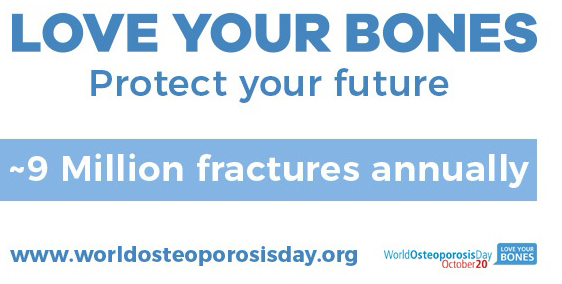
World Osteoporosis Day (WOD) takes place every year on October 20, launching a year-long campaign dedicated to raising global awareness of the prevention, diagnosis and treatment of osteoporosis and metabolic bone disease. Organized by the International Osteoporosis Foundation (IOF) every year, World Osteoporosis Day involves campaigns by national osteoporosis patient societies from around the world with activities in over 90 countries. Events and campaigns take place throughout the months leading up to and following WOD. The campaign slogan is “Love Your Bones.”
What is osteoporosis?
Worldwide, one in three women and one in five men aged 50 years and over will suffer an osteoporotic fracture. Osteoporosis causes bones to become weak and fragile, so that they break easily – even as a result of a minor fall, a bump, a sneeze, or a sudden movement. Fractures caused by osteoporosis can be life-threatening and a major cause of pain and long-term disability.
Prevention
Can osteoporosis and fractures be prevented? Yes, if action is taken early! Read the information provided here to learn which steps you can take to build strong bones throughout life and avoid osteoporotic fractures.
The 5 steps to healthy bones and a fracture-free future:
1. Exercise regularly – Weight-bearing, muscle-strengthening and balance-training exercises are best.
2. Ensure a diet rich in bone-healthy nutrients – Calcium, vitamin D and protein are the most important for bone health. Safe exposure to sunshine will help you get enough vitamin D.
3. Avoid negative lifestyle habits – Maintain a healthy body weight, avoid smoking and excessive drinking.
4. Find out whether you have risk factors – If so, bring these to your doctor’s attention, especially if you’ve had a previous fracture or have specific diseases and medications that affect bone health.
5. Get tested and treated if needed – If you’re at high risk you will likely need medication to ensure optimal protection against fracture
Have risk factors? Talk to your doctor, ask for testing.
To become aware of any potential risk factors, take the IOF One-Minute Osteoporosis Risk Test.
If you are over the age of 50 and you have one or more risk factors you should discuss these with your doctor and ask for an assessment of your bone health status. Lifestyle changes may be recommended and, for those at high risk, medication may be prescribed for optimal protection against fractures.


Be the first to comment